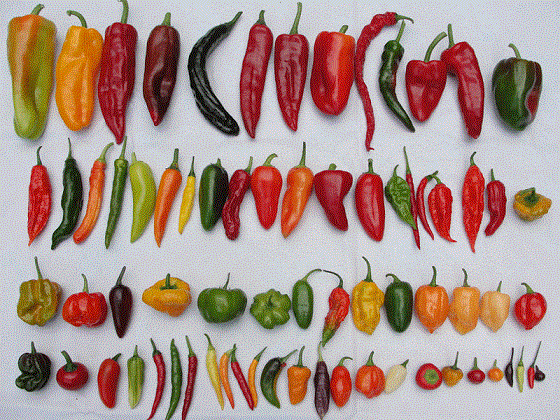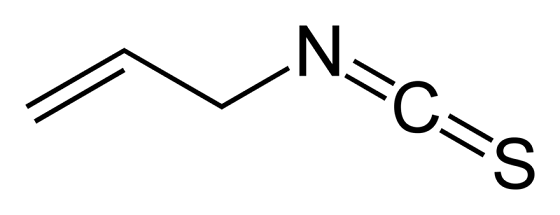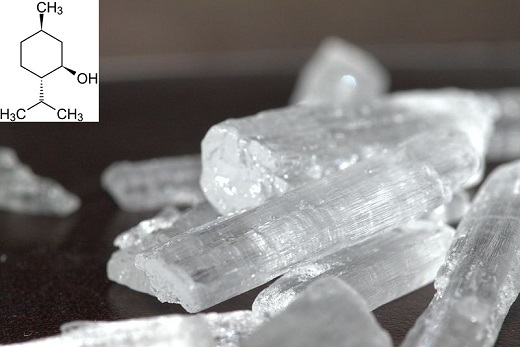How do we recognize temperature or what is common in hot food and hot pepper?
I think that we all many times came across sensations that contact of tongue with mint, wasabi or hot pepper causes. It’s customary to say about mint that it is “refreshing”, and anyone who has tried mint chewing gum will say that they have a cool effect on the mouth (especially if you drink them with cold water or breathe cold air). And about spicy foods, we can say that it burns our tongue; in English, in general, the word “hot” means both hot and spicy foods. And we say so not simply because it is so “historically formed”; it is a subjective consequence of our own sensations. But do such analogies have scientific validity or is this a simple coincidence? Let's figure it out.
Advertising refreshing mint gum will not lie - we all feel the feeling of "cold" in the mouth when using something like that.
So, we are used to dividing objects around us into “hot”, “cold” and those that we simply do not pay attention to. To begin with, let’s see what is really hidden under this.
Everyone who attended high school knows that heat itself is transferred from a warmer body to a less heated one. The idea of adding ice to our drinks is based on this - ice gradually cools them due to the fact that the drink has a water base, and therefore it has a freezing point of zero degrees and below. The ice added to the drinks initially has a temperature below zero, as a result we do not need to worry that our cocktail will quickly heat up (to tell the truth, I have never come across a situation so that the ice in the drink has melted).
')

In the modern world, no one needs to explain why the red pepper in the figure is enveloped in fire. As well as comic videos with people who ate something very spicy and therefore spew fire from the mouth.
Based on this logic, the most comfortable for a person ambient temperature will be 36.6 degrees, but I think it is obvious to all readers that this is not at all the case. The fact is that in the cases above, we are dealing with objects that are not themselves heat sources. But a person very actively releases heat, and if you do not provide the body with the desired heat sink, then you can easily die. A clear demonstration of this fact is the recent death of a 20-year-old British boxer who died while conducting a weight reduction before a fight in a thermal suit . In fact, we feel hot when the environment does not quickly remove heat from our body, so it becomes hot not when the ambient temperature rises above 36.6 degrees, but at a much lower temperature.

System unit with an advanced processor cooler. It is obvious that the surface area of the radiator exceeds the area of the thermal interface by the radiator-processor by orders of magnitude.
It should be borne in mind that different objects have different thermal conductivity. Indeed, the temperature of the air in the room seems very comfortable to us, although we would certainly not like to sleep on an iron bed at room temperature, and the point is not only that it is hard and uncomfortable. The fact is that metal is a much more efficient conductor of heat, so the iron at room temperature seems cold to us, and the air at room temperature is just right for us. For the same reasons, we attach coolers with hefty radiators to overclocked processors and top-end video cards: the air is not able to take enough heat from a plate of several square centimeters. Therefore, at first, the chip transfers heat through the interface of a small area to a metal radiator, and then the cooler radiator having a colossal area transfers energy to the atmosphere. Also, do not forget that the cooler fan provides constant air circulation, which significantly increases the heat transfer between the radiator and the atmosphere. Since the temperature of the radiator is (conditionally) constant, it receives as much energy through the interface a few square centimeters from the chip as it then gives to the atmosphere through a much larger surface.
Now let’s see if there’s a lot in common between hot ’and hot’. “Hot” means that we cannot take enough heat away from ourselves, we overheat and start to feel discomfort of one degree or another all over our body because of this. The concept of “hotly” suggests that we take too much heat from the outside on some specific area of the external surface of the body, that is, the concepts of “hot” and “cold” are already directly connected with our senses on the skin or tongue.
Obviously, the sensations that are caused by the use of hot pepper or something with menthol content are rather in the plane of "hot" and "cold". But is there actually a similarity in the data in general at first sight of external pathogens absolutely different in nature?

The three-dimensional structure of the transmembrane temperature-sensitive receptor TRPV1, which is essentially a temperature-controlled cation channel. Its activation occurs at temperatures above 43 degrees, as well as in acidic and some other conditions, which will be described later.
For a start, let's look at how we recognize the "hot" and "cold."
The fact is that in all thermosensitive tissues there are special thermal sensors, which in fact are to the so-called. "Mechanoreceptors". The term "mechanoreceptor" means that this type of receptor responds to changes in the mechanical properties of the membrane in which it is located (stiffness, viscosity, elasticity, etc.). The membrane is subject to the usual rules for our macro-world: when the temperature rises, it “dilutes”, and when lowered, “coarsens”. In turn, the mechanoreceptor is a transmembrane protein, the spatial structure of which is determined by the stiffness of the surrounding membrane.
If explained on the fingers, then the “mechanoreceptor of temperature increase” in the inactive “zero” position is in a kind of “constrained”, “membrane-compressed” state. As soon as the heated membrane loses its rigidity, the receptor is “unclenched”, and this leads to the appearance of a signal from the “heat receptor”. Similarly, the “mechanoreceptor of lowering the temperature” is in an inactive state with a more “liquid” membrane, and the lowering of the temperature makes it more rigid, which leads to a change in the spatial structure and activation of the “cold receptor”.
In general, all heat-sensitive receptors are transmembrane TRP channels that transmit cations (TRP - Transient Receptor Potential). That is, in an inactive form, the channel is “closed”, and its activation leads to the appearance of a pore, which transmits cations. The temperature range of sensitivity of all receptors is divided between their various types into three intervals.
We now turn to the consideration of what happens when we eat hot pepper or chew mint gum. In this case, naturally, everything is also determined by certain receptors: some components of pepper or peppermint gum interact with them, the receptors are activated and report that "something is happening." As a result, we feel the taste of spicy food or mint freshness in the mouth.
And now the most interesting thing: it turned out that the same receptors are involved in the recognition of temperature and in the recognition of spicy food or something like mint!

The structure of the alkaloid capsaicin molecule, which is part of hot pepper. He is the cause of his particular spicy taste.
Consider a few examples. It was found that the cause of the specific taste of hot red pepper or jalapeno pepper is the alkaloid "capsaicin" and related compounds found in the fruits of these vegetables. Actually, the word “capsaicin” comes from the Latin name for this type of Capsicum annuum (chilli pepper) , to which all peppers falling on our tables belong. Contact with capsaicin on the “hot” receptor TRPV1 leads to its activation and we experience sensations close to the burning effects of hot food. But, of course, it is impossible to draw a full-fledged parallel between the use of hot peppers and burns: “hot painful sensations” from pepper is a kind of evolutionary way of deceiving our body, to which the pepper goes to protect its seeds from being eaten, while high temperatures already represent a real threat to our health.
I mentioned above that capsaicin is a seed protection against eating. In fact, it turned out that everything is not so simple: in nature, there are types of TRPV1 receptor that are immune to the presence of capsaicin. Such a TRPV1 is, for example, in birds. And what is most surprising - this is again on the hand pepper! The fact is that the birds do not chew the seeds, as we do, but rather swallow them whole. Since they do not feel a sharp taste, they willingly peck them, though their digestion is not able to cope with their shell and as a result they leave the bird out unscathed. In this way, the spread of rather heavy (compared to dandelion seeds) seeds over long distances occurs.

A variety of types of capsicum (Capsicum annuum), which includes both sweet Bulgarian pepper and jalapeño pepper.
Judging from the above, TRPV1 can in fact be called the “pain receptor”: indeed, its activation occurs at high temperatures that are dangerous for the body. In addition, it was shown that the poison of some tarantulas also causes pain through the interaction of the components of the poison with the TRPV1 receptor. And one more funny observation: since TRPV1 is essentially a “pain receptor”, then from the point of view of molecular biology, in love of spicy foods, you can find a piece of masochism :-)
It is also important to know that capsaicin is highly soluble in non-polar solvents and poorly soluble in polar ones. From here we can make an important conclusion: if we want to “wash” the oral cavity from capsaicin, then we need to rinse our mouth with something that contains non-polar solvents. Fats (for example, they are contained in dairy products and oils) or alcohols (alcoholic beverages) can be used in this role. Rinsing the mouth with water is not very effective, since water is a polar solvent, so capsaicin is slightly soluble in water. But in fact, it is better to wash the oral cavity with fat-containing products, since ethanol is a factor that increases the sensitivity of TRPV1 to capsaicin and can potentially even aggravate discomfort.
In short, all those who in TV shows and films drink spicy food with cold water do not act in the most correct way.

The structural formula of allyl isothiocyanate is the "acute" component of mustard, wasabi and horseradish.
Another example of spicy food is mustard, which we will look at as an example of exposure to the skin. As everyone knows, mustard is the main component of mustard plaster. The fact is that the wetting of a mustard plaster triggers an enzymatic reaction in mustard powder, the product of which is a compound called “allyl isothiocyanate”. It in turn penetrates the skin, where it interacts with the TRPA1 and TRPV1 receptors and thereby causes a slight local inflammation and, as a result, a local increase in body temperature. By the way, on the basis of capsaicin there is also a warming up ointment. Indications for its use are neuralgia associated with shingles, an acute painful condition caused by the Varicella zoster virus (chickenpox, also chickenpox). Capsaicin-containing ointments are also used to treat mild to moderate arthritis, diabetic neuropathy, and postoperative pain.

Menthol crystals - the refreshing component of mint. In the upper left corner is its structural formula.
Now consider the “refreshing” compounds. The key component of peppermint in this case is menthol, which interacts with the TRPM8 receptor (TRPM8 is a cold receptor that responds to temperatures below 25 degrees). Getting into the oral cavity, it activates the "cold receptors", and the interaction of menthol with the olfactory in the nose greatly facilitates understanding. As well as allyl isothiocyanate, obtained from mustard plasters, menthol can be used not only in food or as a flavoring agent. The fact is that menthol has the opposite effect of allyl isothiocyanate. That is why menthol is often present in preparations that reduce cold symptoms: it is able to reduce the level of inflammation in the throat, in essence being a local anesthetic. There are even cooling gels containing menthol. Manufacturers argue that such drugs alleviate pain in muscles and joints, as well as reduce swelling and hematomas, but I find it difficult to assess their effectiveness, as I have never encountered them.
Ethanol affects not only the sensitivity of capsaicin receptors, but also the sensitivity of TRPM8, although if there is an increase in sensitivity in the case of TRPV1, in the case of menthol the alcohol decreases its sensitivity.

I think everyone remembers the reason why this photo was famous . As we see the dress in different colors, so, in theory, we could completely differently perceive the taste of hot pepper, onion and garlic. There is generally an analogy with the differences in color vision: objectively there is neither red nor blue colors, the only question is how do we perceive certain wavelengths of electromagnetic radiation.
But wait, it turns out that the same receptors, capsaicin (menthol, allylisothiocyanate), exist on the tongue and on the skin. However, when contacting with capsaicin, different effects appear, albeit similar, but still different: in the language, capsaicin causes a sensation of sharpness, on the skin it causes local inflammation, and when it comes into eyes, it is generally a powerful tear irritant. How is it, because the same receptors are everywhere? The whole point is that there are many intermediate stages between the receptor and the brain, and it is these intermediate stages that differ greatly in each of the above cases. Generally speaking, in theory, with the help of genetic engineering, everything in this system can be confused: for example, by changing some stages of signal transmission from the capsaicin receptor to the brain, it is quite possible to turn hot peppers, onions, and garlic from burning seasonings into breath fresheners.
The story of the relationship of temperature and taste can go on and on. For example:
Another thing is important. Thanks to the success in understanding the molecular nature of taste and temperature sensations, physicians can create more and more new medicines, and cooks will create and improve their culinary masterpieces.
Advertising refreshing mint gum will not lie - we all feel the feeling of "cold" in the mouth when using something like that.
So, we are used to dividing objects around us into “hot”, “cold” and those that we simply do not pay attention to. To begin with, let’s see what is really hidden under this.
Everyone who attended high school knows that heat itself is transferred from a warmer body to a less heated one. The idea of adding ice to our drinks is based on this - ice gradually cools them due to the fact that the drink has a water base, and therefore it has a freezing point of zero degrees and below. The ice added to the drinks initially has a temperature below zero, as a result we do not need to worry that our cocktail will quickly heat up (to tell the truth, I have never come across a situation so that the ice in the drink has melted).
')

In the modern world, no one needs to explain why the red pepper in the figure is enveloped in fire. As well as comic videos with people who ate something very spicy and therefore spew fire from the mouth.
Based on this logic, the most comfortable for a person ambient temperature will be 36.6 degrees, but I think it is obvious to all readers that this is not at all the case. The fact is that in the cases above, we are dealing with objects that are not themselves heat sources. But a person very actively releases heat, and if you do not provide the body with the desired heat sink, then you can easily die. A clear demonstration of this fact is the recent death of a 20-year-old British boxer who died while conducting a weight reduction before a fight in a thermal suit . In fact, we feel hot when the environment does not quickly remove heat from our body, so it becomes hot not when the ambient temperature rises above 36.6 degrees, but at a much lower temperature.

System unit with an advanced processor cooler. It is obvious that the surface area of the radiator exceeds the area of the thermal interface by the radiator-processor by orders of magnitude.
It should be borne in mind that different objects have different thermal conductivity. Indeed, the temperature of the air in the room seems very comfortable to us, although we would certainly not like to sleep on an iron bed at room temperature, and the point is not only that it is hard and uncomfortable. The fact is that metal is a much more efficient conductor of heat, so the iron at room temperature seems cold to us, and the air at room temperature is just right for us. For the same reasons, we attach coolers with hefty radiators to overclocked processors and top-end video cards: the air is not able to take enough heat from a plate of several square centimeters. Therefore, at first, the chip transfers heat through the interface of a small area to a metal radiator, and then the cooler radiator having a colossal area transfers energy to the atmosphere. Also, do not forget that the cooler fan provides constant air circulation, which significantly increases the heat transfer between the radiator and the atmosphere. Since the temperature of the radiator is (conditionally) constant, it receives as much energy through the interface a few square centimeters from the chip as it then gives to the atmosphere through a much larger surface.
Now let’s see if there’s a lot in common between hot ’and hot’. “Hot” means that we cannot take enough heat away from ourselves, we overheat and start to feel discomfort of one degree or another all over our body because of this. The concept of “hotly” suggests that we take too much heat from the outside on some specific area of the external surface of the body, that is, the concepts of “hot” and “cold” are already directly connected with our senses on the skin or tongue.
Obviously, the sensations that are caused by the use of hot pepper or something with menthol content are rather in the plane of "hot" and "cold". But is there actually a similarity in the data in general at first sight of external pathogens absolutely different in nature?

The three-dimensional structure of the transmembrane temperature-sensitive receptor TRPV1, which is essentially a temperature-controlled cation channel. Its activation occurs at temperatures above 43 degrees, as well as in acidic and some other conditions, which will be described later.
For a start, let's look at how we recognize the "hot" and "cold."
The fact is that in all thermosensitive tissues there are special thermal sensors, which in fact are to the so-called. "Mechanoreceptors". The term "mechanoreceptor" means that this type of receptor responds to changes in the mechanical properties of the membrane in which it is located (stiffness, viscosity, elasticity, etc.). The membrane is subject to the usual rules for our macro-world: when the temperature rises, it “dilutes”, and when lowered, “coarsens”. In turn, the mechanoreceptor is a transmembrane protein, the spatial structure of which is determined by the stiffness of the surrounding membrane.
If explained on the fingers, then the “mechanoreceptor of temperature increase” in the inactive “zero” position is in a kind of “constrained”, “membrane-compressed” state. As soon as the heated membrane loses its rigidity, the receptor is “unclenched”, and this leads to the appearance of a signal from the “heat receptor”. Similarly, the “mechanoreceptor of lowering the temperature” is in an inactive state with a more “liquid” membrane, and the lowering of the temperature makes it more rigid, which leads to a change in the spatial structure and activation of the “cold receptor”.
In general, all heat-sensitive receptors are transmembrane TRP channels that transmit cations (TRP - Transient Receptor Potential). That is, in an inactive form, the channel is “closed”, and its activation leads to the appearance of a pore, which transmits cations. The temperature range of sensitivity of all receptors is divided between their various types into three intervals.
- Thermoreceptors of the first type are responsible for recognizing temperatures much higher than body temperature. They warn us that you can get burned: when activated, a person will feel sharp pain and will instinctively try to avoid contact with a heat source. Thus, they can still be counted as “receptors of pain,” although from a biology point of view this sounds damn silly;
- Thermal receptors of the second type recognize near-physiological temperatures (that is, close to 36.6);
- Finally, third-type temperature receptors are activated by temperatures below the physiological level. Excited or a signal we end up with as a “cold”.
We now turn to the consideration of what happens when we eat hot pepper or chew mint gum. In this case, naturally, everything is also determined by certain receptors: some components of pepper or peppermint gum interact with them, the receptors are activated and report that "something is happening." As a result, we feel the taste of spicy food or mint freshness in the mouth.
And now the most interesting thing: it turned out that the same receptors are involved in the recognition of temperature and in the recognition of spicy food or something like mint!

The structure of the alkaloid capsaicin molecule, which is part of hot pepper. He is the cause of his particular spicy taste.
Consider a few examples. It was found that the cause of the specific taste of hot red pepper or jalapeno pepper is the alkaloid "capsaicin" and related compounds found in the fruits of these vegetables. Actually, the word “capsaicin” comes from the Latin name for this type of Capsicum annuum (chilli pepper) , to which all peppers falling on our tables belong. Contact with capsaicin on the “hot” receptor TRPV1 leads to its activation and we experience sensations close to the burning effects of hot food. But, of course, it is impossible to draw a full-fledged parallel between the use of hot peppers and burns: “hot painful sensations” from pepper is a kind of evolutionary way of deceiving our body, to which the pepper goes to protect its seeds from being eaten, while high temperatures already represent a real threat to our health.
I mentioned above that capsaicin is a seed protection against eating. In fact, it turned out that everything is not so simple: in nature, there are types of TRPV1 receptor that are immune to the presence of capsaicin. Such a TRPV1 is, for example, in birds. And what is most surprising - this is again on the hand pepper! The fact is that the birds do not chew the seeds, as we do, but rather swallow them whole. Since they do not feel a sharp taste, they willingly peck them, though their digestion is not able to cope with their shell and as a result they leave the bird out unscathed. In this way, the spread of rather heavy (compared to dandelion seeds) seeds over long distances occurs.

A variety of types of capsicum (Capsicum annuum), which includes both sweet Bulgarian pepper and jalapeño pepper.
Judging from the above, TRPV1 can in fact be called the “pain receptor”: indeed, its activation occurs at high temperatures that are dangerous for the body. In addition, it was shown that the poison of some tarantulas also causes pain through the interaction of the components of the poison with the TRPV1 receptor. And one more funny observation: since TRPV1 is essentially a “pain receptor”, then from the point of view of molecular biology, in love of spicy foods, you can find a piece of masochism :-)
It is also important to know that capsaicin is highly soluble in non-polar solvents and poorly soluble in polar ones. From here we can make an important conclusion: if we want to “wash” the oral cavity from capsaicin, then we need to rinse our mouth with something that contains non-polar solvents. Fats (for example, they are contained in dairy products and oils) or alcohols (alcoholic beverages) can be used in this role. Rinsing the mouth with water is not very effective, since water is a polar solvent, so capsaicin is slightly soluble in water. But in fact, it is better to wash the oral cavity with fat-containing products, since ethanol is a factor that increases the sensitivity of TRPV1 to capsaicin and can potentially even aggravate discomfort.
In short, all those who in TV shows and films drink spicy food with cold water do not act in the most correct way.

The structural formula of allyl isothiocyanate is the "acute" component of mustard, wasabi and horseradish.
Another example of spicy food is mustard, which we will look at as an example of exposure to the skin. As everyone knows, mustard is the main component of mustard plaster. The fact is that the wetting of a mustard plaster triggers an enzymatic reaction in mustard powder, the product of which is a compound called “allyl isothiocyanate”. It in turn penetrates the skin, where it interacts with the TRPA1 and TRPV1 receptors and thereby causes a slight local inflammation and, as a result, a local increase in body temperature. By the way, on the basis of capsaicin there is also a warming up ointment. Indications for its use are neuralgia associated with shingles, an acute painful condition caused by the Varicella zoster virus (chickenpox, also chickenpox). Capsaicin-containing ointments are also used to treat mild to moderate arthritis, diabetic neuropathy, and postoperative pain.

Menthol crystals - the refreshing component of mint. In the upper left corner is its structural formula.
Now consider the “refreshing” compounds. The key component of peppermint in this case is menthol, which interacts with the TRPM8 receptor (TRPM8 is a cold receptor that responds to temperatures below 25 degrees). Getting into the oral cavity, it activates the "cold receptors", and the interaction of menthol with the olfactory in the nose greatly facilitates understanding. As well as allyl isothiocyanate, obtained from mustard plasters, menthol can be used not only in food or as a flavoring agent. The fact is that menthol has the opposite effect of allyl isothiocyanate. That is why menthol is often present in preparations that reduce cold symptoms: it is able to reduce the level of inflammation in the throat, in essence being a local anesthetic. There are even cooling gels containing menthol. Manufacturers argue that such drugs alleviate pain in muscles and joints, as well as reduce swelling and hematomas, but I find it difficult to assess their effectiveness, as I have never encountered them.
Ethanol affects not only the sensitivity of capsaicin receptors, but also the sensitivity of TRPM8, although if there is an increase in sensitivity in the case of TRPV1, in the case of menthol the alcohol decreases its sensitivity.

I think everyone remembers the reason why this photo was famous . As we see the dress in different colors, so, in theory, we could completely differently perceive the taste of hot pepper, onion and garlic. There is generally an analogy with the differences in color vision: objectively there is neither red nor blue colors, the only question is how do we perceive certain wavelengths of electromagnetic radiation.
But wait, it turns out that the same receptors, capsaicin (menthol, allylisothiocyanate), exist on the tongue and on the skin. However, when contacting with capsaicin, different effects appear, albeit similar, but still different: in the language, capsaicin causes a sensation of sharpness, on the skin it causes local inflammation, and when it comes into eyes, it is generally a powerful tear irritant. How is it, because the same receptors are everywhere? The whole point is that there are many intermediate stages between the receptor and the brain, and it is these intermediate stages that differ greatly in each of the above cases. Generally speaking, in theory, with the help of genetic engineering, everything in this system can be confused: for example, by changing some stages of signal transmission from the capsaicin receptor to the brain, it is quite possible to turn hot peppers, onions, and garlic from burning seasonings into breath fresheners.
The story of the relationship of temperature and taste can go on and on. For example:
- Contact of the tip of the tongue with an object whose temperature is 35 degrees causes a faint sweet taste;
- Contact of the tongue with an object whose temperature is about 5 degrees causes a salty taste. So when we drink cold water, it may seem to us that salt is added to it;
- And so on and so forth…
Another thing is important. Thanks to the success in understanding the molecular nature of taste and temperature sensations, physicians can create more and more new medicines, and cooks will create and improve their culinary masterpieces.
Source: https://habr.com/ru/post/373313/
All Articles